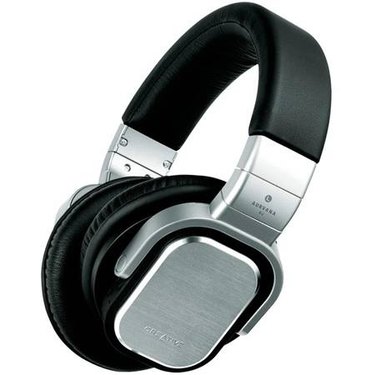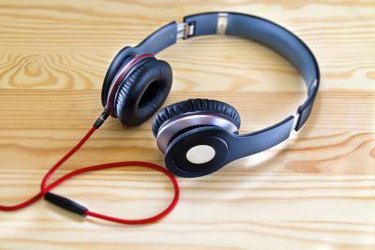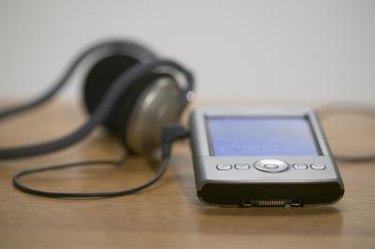

Basic Materials

From the time they were invented in 1910 by Nathaniel Baldwin, headphones have been a staple of communication across the globe. Of course, as with any technology, they have gone through design changes, new applications have been devised for the them, and they have been manufactured in many different ways.
The very first headphones were comprised of handmade materials that were readily available such as rubber, leather, copper, and ceramics. Headphones in more modern times still are made based on the same principles but highly advanced. Headphones are now mass-produced and made with a wide spectrum of different materials including vinyl, foam, silicone, advanced plastics, artificial leather, textiles and more.
Video of the Day
Video of the Day
Ever since headphones were invented by Nathaniel Baldwin in 1910, they have undergone a radical evolution in style, design and performance. Early headphones were largely handmade and constructed from materials common to electrical products of the era---mainly copper, rubber, leather and technical ceramics. Modern headphones are generally highly engineered, mass-produced and made with sophisticated plastics, silicone, artificial leather, rubber, textiles, vinyl and foam materials.
Types of Headphones

The way that headphones are designed and the materials used are based largely on their application and price point. When the decision to purchase new headphones is made, one must weigh what their use will be.
Headphones come in a wide spectrum of designs, but there are a few designs that are the most prevalent in the marketplace. Each design has its own advantages and disadvantages as with any product.
The most common types of headphones are ear bud (partially inserted into the ear canal), super-aural (cushioned against the ear), in-ear (fully inserted into the ear canal), and circumaural (around the ear). The design and application of headphones dictate the material used to make them.
Ear Buds

The materials used to construct ear bud headphones have to be able to stand up to constant abuse coupled with wear and tear. This is mainly because ear buds are partially inserted into the ear. The most common material choices in this design include two tough plastic materials; polycarbonate (PC) and polyester.
Around the Ear

Circumaural (around the ear) headphones envelop both ears completely and are the largest type of headphone. In addition, they are comprised of the widest range of materials. Some common materials used in the construction of Circumaural headphones include polyurethane, faux leather filled with foam, real leather, and an array of textiles including plush, velvet, and velour.
In the Ear

The design of in-ear headphones is important because they are inserted into the ear canal and susceptible to carrying germs, which can cause ear infections. The garden variety in-ear headphones are most often made with synthetic or natural rubbers. However, there are some types that are are made of hypoallergenic and sometimes medical grade silicones.
Against the Ear

The most common materials used in supra-aural (against the ear) headphones are PVC, rubber, memory foam, and artificial leather. They are held on by a piece of plastic that bends around the head.
Common Transducer Designs

A transducer is the technical term for speaker. Listed below are some of the different transducer designs used in headphone manufacture.
Moving Coil
The moving coil driver is the most common type of transducer used in headphones. A common name for this type of transducer is ''dynamic." The stationary magnet attached to the supporting frame of the headphone creates a static magnetic field. The main components of this type of magnet are either neodymium or a ferrite composite. The diaphragm of the headphone is affixed to the voice coil. Sound is generated when audio passes through the coil and the alternate and static magnetic fields clash. A common type of moving-coil headphone drivers are based on microphone capsule technology.
Electret
An electret transducer functions by carrying a permanent built-in charge. They are not a very common design type and neither are their close relative, the electrostatic transducer. In addition they are cheaper and cannot reproduce the same fidelity as electrostatics.
Electrostatic
The drivers in an electrostatic transducer are comprised of a very thin charged electrical diaphragm. It is common for a PET film membrane to be placed between two perforated metal plates. The sound signal creates an electrical field. Air is then forced through the perforations and then is merged with an ever-changing electrical signal that drives the membrane. This process causes a sound wave to be generated. Electrostatic headphones are usually more expensive than their moving-coil counterparts due to their wider frequency range and the quality of the components used in the manufacturing process.
Manufacturing Process

Headphones are made by a combination of hand and machine methods. The internal speaker configuration on the headphones must be wired first before being placed in the headphone casing. This is generally done in an assembly line manner with several workers being responsible for a small part of the process. One worker may wire the speaker configuration into the headset while another may be responsible for just assembling the parts of the pre-molded casing.
Most headphone casings are made by machines to save time and money. The outer casings of most headphones is made of molded plastic and thus created by a set of molds at the factory.
After a pair of headphones has been completely assembled they are tested in the factory. Nowadays the testing is done by a computer. The computer program sends sound waves through the headphones to test the frequency response.